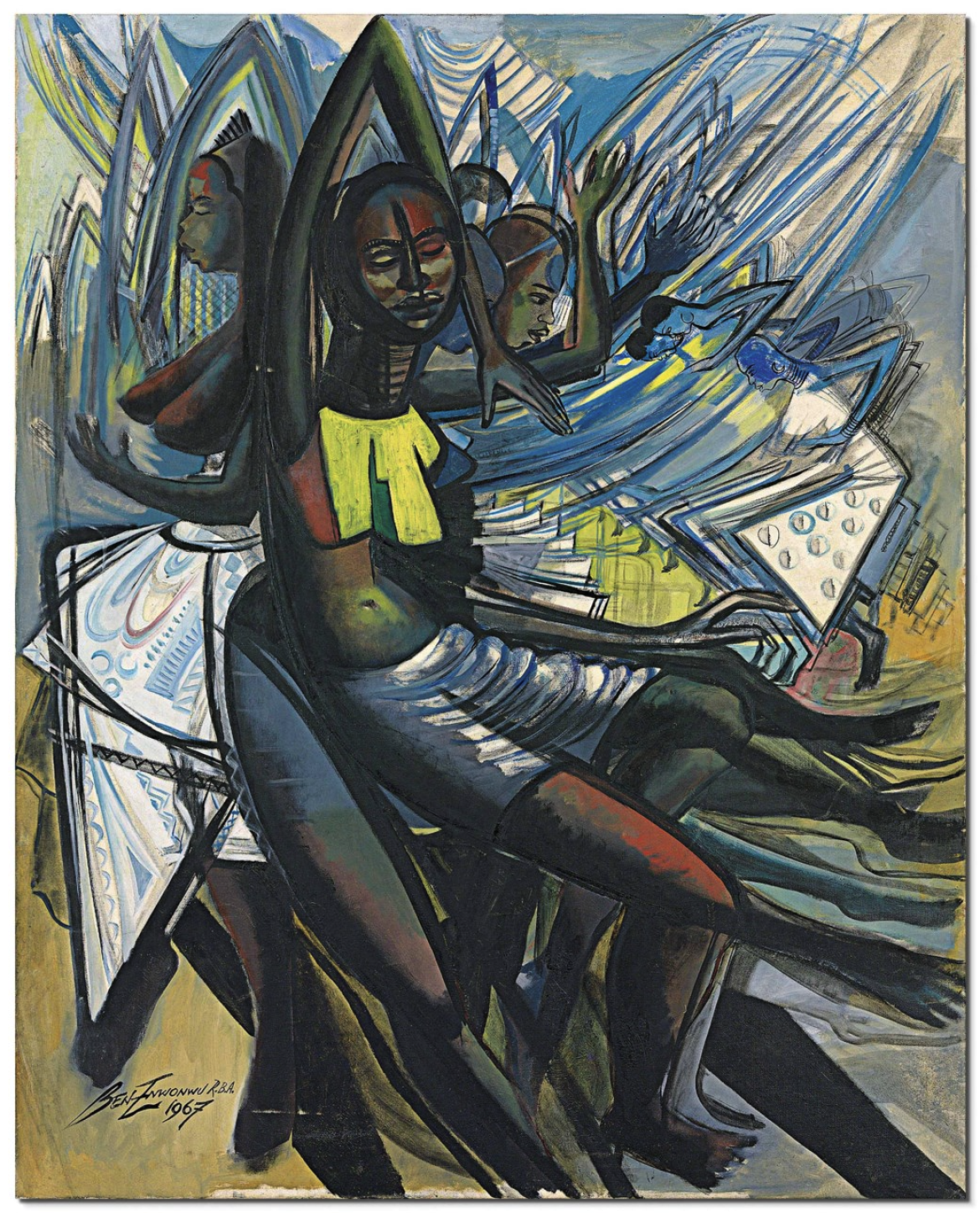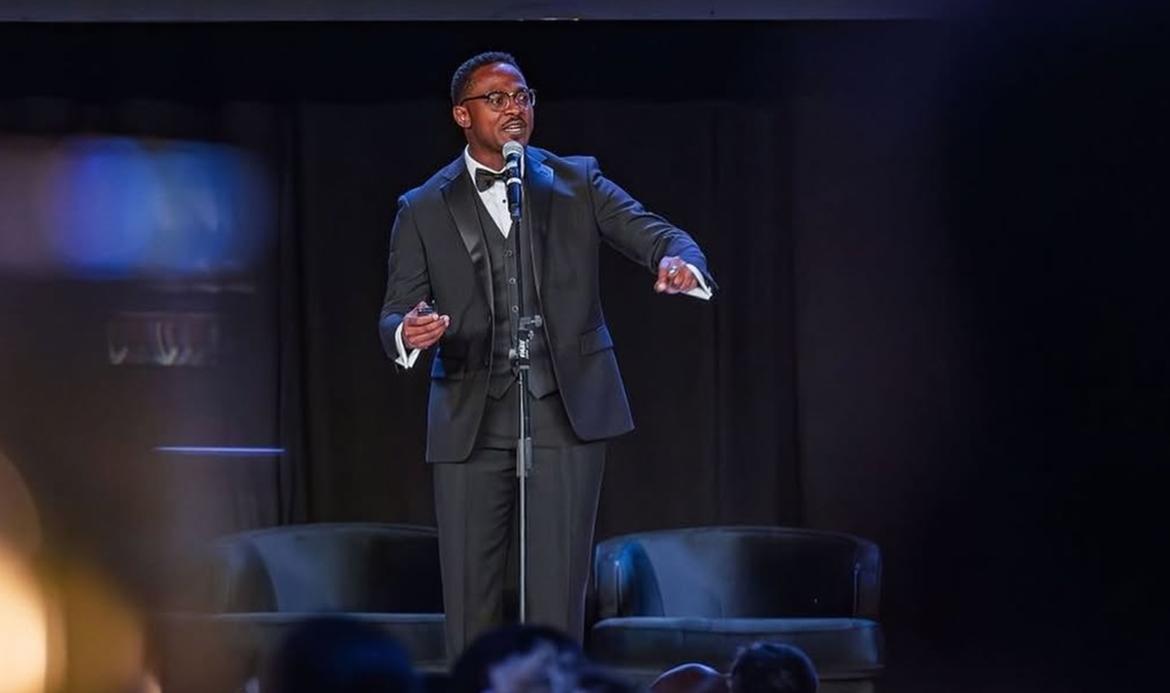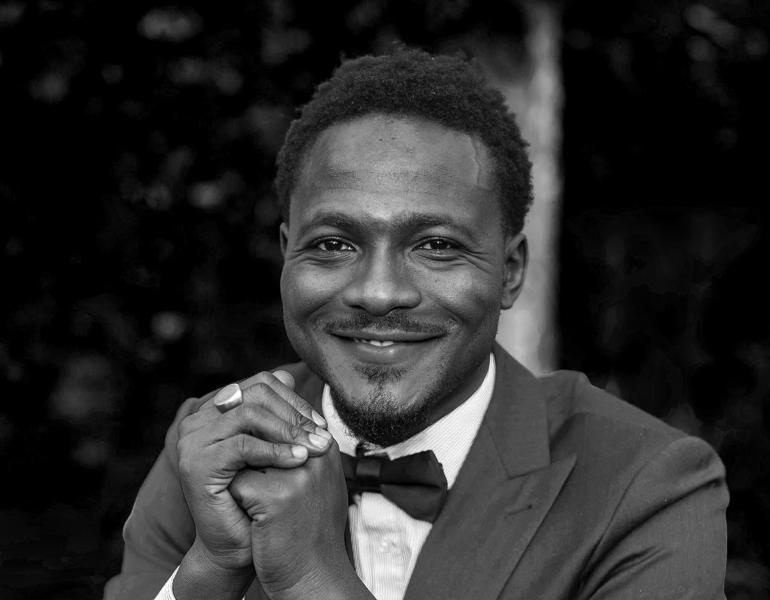The Meet The Artist series highlights talented performing arts professionals from diverse backgrounds. We’re back with this month’s featured artist. We encourage you to read these interviews with an open mind, and to remember that starting a relationship with an artist can be something smaller than a mainstage show such as inviting them to lead a workshop, sit on a panel, or collaborate with another artist.
This month, Ksenija Spasic interviewed visual artist, spoken-word poet, and architectural designer Komi Olaf.
You are a painter and performer. Could you talk about the interplay of these two creative identities, their differences and similarities? What kinds of performance have you done and what do you love about it?
I started painting and performing spoken word poetry around the same time, in 2006. The two forms of expression have always been linked for me. I find it easier to describe my paintings as poems and, often, inspiration for a painting sprouts from a poem I’m writing.
During spoken word performances, there are moments when words can be altered, delivery slowed or sped up to create a necessary effect. Live art is malleable and dynamic. Writing poetry and painting are meditative; they require long periods of solitude and reflection, but with spoken word and live painting, I am thrust out of my comfort zone to interact and engage an audience which is thrilling for me and for them, I hope.
I have done live painting performances while reciting poetry with a headset mic. My spoken word performance might include a live band or a slideshow. There are moments when listener and performer are in sync, when an audience resonates with the message or feelings of a poem. I strive to find ways to wow the audience, to keep them vibrating at that same frequency even after the show is done.
Was there an initiating moment or moments that turned you towards artmaking? Could you talk a little bit about your creative influences?
I was studying architecture and signed up for an architectural painting course. Once the course started and I had the opportunity to paint on canvas for the first time, it was like a bulb exploded in my head. I was hooked.
I continued to teach myself about painting and developed admiration for many artists: some for their technical abilities like Caravaggio, Justin Bua, and Ben Enwonwu, others for the scale of their works, like Diego Rivera and Michelangelo. I was drawn to the lives of artists. I wanted to know what drove people like Frida Kahlo and Twins Seven Seven to keep creating despite seemingly insurmountable odds.
For spoken word poetry, I listened to a lot of Def Poetry Jam and eventually wrote a poem which I performed at a showcase. People kept asking me to perform, so I had to create more material and that was how my spoken word journey began. I look up to poets like Sunni Patterson, Ian Keteku, Saul Williams, The Last Poets and Gil Scott-Heron.
Image

What is the main value of spoken word poetry to you and what are your thoughts on this artform’s future?
My first poem was about quitting smoking. For me, spoken word can be very therapeutic. It is an outlet to voice one’s opinions on social issues or express emotions buried deep within. It can excite an audience and bring them to tears in the space of a few sentences. I found that, as a form of expression, it is so pure. The parameters and structures that govern written poetry are looser in spoken word.
There is often room for musical accompaniment, which provides an opportunity to collaborate with other artists. This can often be improvised or executed with limited practice, making the results loose and organic. Sometimes, during a performance, a lot of information can be dropped quickly. I have found that strategic silences between words, sentences or stanzas can highlight a certain point in the poem or give a line of poetry time to be fully absorbed by the audience. I equate this to the use of negative space in a painting.
I see spoken word as a sort of bridge between written page poetry and rap. The art form has been around for thousands of years and continues to thrive. In West Africa, oral histories of people and places are still kept and told by griots - storytellers, historians, praise-singers, poets, and musicians. The artform has taken different shapes for different generations. Right now, we use “spoken word” to describe all kinds of poetic performance, but, in the future, it may evolve into more clearly defined sub-genres as we continue to experiment with the production of spoken word albums, films, animations and especially through slam poetry.
Image

Are there any recurring themes in your work? Where do they stem from and why are they important?
Love, Religion, Pan-African ideas and Afrofuturistic themes feature often in my work. I grew up in Northern Nigeria and migrated to Canada after highschool.
Many of my experiences in Nigeria found their way into my poems and paintings. As a young adult figuring out my new identity as an Afro-Canadian, I often spoke about the complexity of the experiences I was having with love: falling in love, falling out of love, searching for love, love for God, love for my country, love of peace.
Ontario Presents aims to connect artists with venues across Ontario. Could you talk about the different places you’ve performed, in Ontario and elsewhere in Canada? What have your experiences been with audiences in those places?
I have performed all over Ontario, in places like Ottawa, Toronto, London and Guelph. Ottawa was where I had my start as a performer, and the encouragement from the audiences, especially at an event called “Urban Legends,” held at Carleton University, spurred me on to create and experiment with the writing and performance. Most recently, I performed in Guelph at a venue called Silence Sounds. It was an intimate space, and the energy in the room was charged. I got to debut a new poem titled “The Space Between Us” about the isolation felt during the pandemic. After the show, a few audience members approached me to talk about how the poem spoke to their personal experiences and I was reminded about the beauty of connecting through words.
I have also performed in other provinces: British Columbia, Saskatchewan, Alberta and Quebec. When I performed in Halifax, it was my first time in Nova Scotia. My hosts were most gracious and I got to see parts of the city before my performance. I remember leaving the venue feeling excited to write, inspired by the event and the city.
What was your most recent performance? What did you learn from creating and delivering it and what do you hope your audience took away?
I most recently performed at the BlackNorth Initiative Excellence Gala 2024, at The Westin Harbour Castle. I learned to be flexible and open to changes. I also learned that having multiple elements of engagement can really enhance the performance. The audience saw a series of my paintings as a slideshow while I performed the poem. I touched on ideas of collective awakening, choice, revolution, reparations, family, beauty; I mentioned Louis Riel and the Red River Rebellion. The Black Canadian experience is one of resilience. We come from many different countries and often have hyphenated identities. Through the performance, I sought to highlight the fact that there is power when we gather together and share stories as Canadians. I hope the audience was inspired and encouraged to explore some of the topics referred to in the poem. I hope they left proud of who they are.
What are your wishes for 2025?
In 2025, I hope for more performances in different communities and to broaden the content of my poems. I hope to address issues that impact groups whose stories are unheard or misunderstood by the public. I would love to work with a choir. I find that the combination of spoken word poetry and choral singing is seldom explored and could create a new, engaging sound. My spoken word work grew and matured in the slam poetry space, so I got accustomed to writing poems under three minutes long. But in my recently published poetry book, Three Hundred Poems, I explored writing shorter verse, often three or four lines long. I am now ready to explore the creation of longer works, to really carry and unfold an idea through an epic long poem.
Contact Komi:
Website: www.komiolaf.com
Email: komi.olaf08 [at] gmail.com (komi[dot]olaf08[at]gmail[dot]com)

